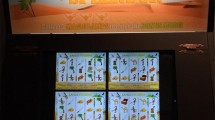Abstract
Slot machines are the most “addictive” games because (a) the disorder (pathological gambling) appears more rapidly in these games than with any other; (b) most patients who seek professional help are mainly addicted to electronic gambling, and (c) even though it is not the more frequent game, most of all the money spent on legal games of chance (at least in Spain) goes to slot machines. Structural characteristics of slot machines induce to gamble because electronic games show the main parameters of operant conditioning, mainly the immediacy of the reinforcement. Ten pathological gamblers played slot machine in two conditions: immediate and delayed reinforcement. The results corroborate the importance of the immediacy of the reinforcement in gambling, because when the result appears immediately (after 2 s), more games are played than when the result is delayed only 10 s. Critical issues in problem gambling prevention and public health are discussed.

Similar content being viewed by others
References
Becoña, E. (2004). El juego patológico: prevalencia en España. Salud y Drogas, 4, 9–34.
Breen, R. B. (2000, June). Rapid onset on pathological gambling in machine gambling compared with other forms. Paper presented at the 11th international conference on gambling and risk taking, Las Vegas, NV.
Breen, R. B., & Zimmerman, M. (2005). Rapid onset of pathological gambling in machine gamblers. Journal of Gambling Studies, 18, 31–43.
Chóliz, M. (2006). Adicción al juego: sesgos y heurísticos implicados en el juego de azar. Revista Española de Drogodependencias, 31, 173–184.
Chóliz, M. (2008). Adicción al juego de azar. Buenos Aires: Deauno.com.
Coventry, K. R., & Constable, B. (1999). Physiological arousal and sensation-seeking in female fruit machine gamblers. Addiction, 94, 425–430.
Dickerson, M. G. (1990). Gambling: the psychology of a non-drug compulsion. Drug and Alcohol Review, 9, 187–199.
Echeburúa, E., & Báez, C. (1994). Concepto y evaluación del juego patológico. In J. L. Graña (Ed.), Conductas Adictivas (pp. 521–556): Madrid: Debate.
Fernández-Alba, A., & Labrador, F. (2005). Sociodemographic, psychopathological and clinical characteristics of pathological slot-machine gamblers in treatment: A descriptive study of Spanish male gamblers. International Gambling Studies, 5, 113–122.
Ferster, C. B., & Skinner, B. F. (1957). Schedules of reinforcement. Englewood Cliffs: Prentice-Hall.
Garvía, R. (2008). Loterías: un estudio desde la nueva sociología económica. Madrid: Centro de Investigaciones Sociológicas.
Griffiths, M. (1993a). Tolerance in gambling: An objective measure using the psychophysiological analysis of male fruit machine gamblers. Addictive Behaviors, 18, 365–372.
Griffiths, M. (1993b). Fruit machine gambling: The importance of structural characteristics. Journal of Gambling Studies, 9, 101–120.
Griffiths, M. (1994). The role of cognitive bias and skill in fruit machine gambling. British Journal of Psychology, 85, 351–369.
Harrigan, K. A. (2008). Slot machine structural characteristics: Creating near misses using high award symbol ratios. International Journal of Mental Health and Addiction, 6, 353–368.
Haw, J. (2008). Random-ratio schedules of reinforcement: The role of early wins and unreinforced trials. Journal of Gambling Issues, 21, 56–67.
Jackson, A. C., Thomas, S. A., Thomason, N., Holt, T. A., & McCormack, J. (2000). Analysis of clients presenting to break even problem gambling services, July 1 1998 to June 20 1999. Client and Service Analysis Report no 5. Melbourne, Victoria: Victorian Department of Human Services.
Kassinove, J. I., & Schare, M. L. (2001). Effects of the “near miss” and the “big win” on persistence at slot machine gambling. Psychology of Addictive Behaviors, 15, 155–158.
Korn, D. A., & Shaffer, H. J. (1999). Gambling and the health of the public: Adopting a public health perspective. Journal of Gambling Studies, 15, 289–368.
Lieberman, D. A., McIntosh, D. C., & Thomas, G. V. (1979). Learning when reward is delayed: A marking hypothesis. Journal of Experimental Psychology: Animal Behavior Processes, 5, 224–242.
McConaghy, N., Blaszczynski, A., & Frankova, A. (1991). Comparison of imaginal desensitisation with other behavioural treatments of pathological gambling. A two- to nine-year follow-up. The British Journal of Psychiatry, 159, 390–393.
Moodie, C., & Finnigan, F. (2005). A comparison of the autonomic arousal of frequent, infrequent and non-gamblers while playing fruit machines. Addiction, 100, 51–59.
Parke, J., & Griffiths, M. (2002, February). Slot machine gamblers—Why are they so hard to study? Electronical Journal of Gambling Issues: eGambling, 6. Retrieved June 24, 2005 from http://www.camh.net/egambling/issue6/index.html.
Parke, J., & Griffiths, M. (2006). The psychology of the fruit machine: The role of structural characteristics (Revisited). International Journal of Mental Health and Addiction, 4(2), 151–179.
Reid, R. L. (1986). The psychology of the near miss. Journal of Gambling Behavior, 2, 32–39.
Schwartz, D. G. (2006). Roll the bones: The history of gambling. New York: Gotham Books.
SDI, Spanish Department of Interior (2009, April). Informe de Juego 2008. Retrieved May 17, 2009 from http://www.mir.es/sgacavt/juegosyespec/juego/.
Turner, N. E., & Horbay, R. (2004, July). How do slot machines and other electronic gambling machines actually work? Electronic Journal of Gambling Issues: eGambling, 11. Retrieved August 13, 2004, from http://www.camh.net/egambling/issue11/index.html
Verdú, F., Tomás, S., Cano, L., Castellano, M., & Delicado, A. (2008, April). Estudio sobre los hábitos de juego en la Comunitat Valenciana. Paper presented at the 35th Jornadas Nacionales de Socidrogalcohol, La Coruña, Spain.
Weatherly, J. N., & Phelps, B. J. (2006). The pitfalls of studying gambling behaviour in a laboratory situation. In P. M. Ghezzi, C. A. Lyons, M. R. Dixon, & G. A. Wilson (Eds.), Gambling: Behavior theory, research, and application (pp. 105–125). Reno, NV: Context Press.
Weatherly, J. N., Sauter, J. M., & King, B. M. (2004). The “big win” and resistance to extinction when gambling. The Journal of Psychology, 138, 495–504.
Wykes, A. (1964). The complete illustrated guide to gambling. Garden City: Doubleday & Company, Inc.
Zlomke, K. R., & Dixon, M. R. (2006). Modification of slot-machine preferences through the use of a conditional discrimination paradigm. Journal of Applied Behavior Analysis, 39, 351–361.
Author information
Authors and Affiliations
Corresponding author
Rights and permissions
About this article
Cite this article
Chóliz, M. Experimental Analysis of the Game in Pathological Gamblers: Effect of the Immediacy of the Reward in Slot Machines. J Gambl Stud 26, 249–256 (2010). https://doi.org/10.1007/s10899-009-9156-6
Published:
Issue Date:
DOI: https://doi.org/10.1007/s10899-009-9156-6




